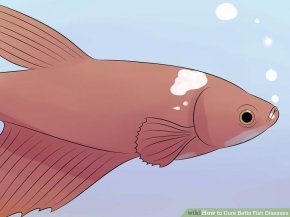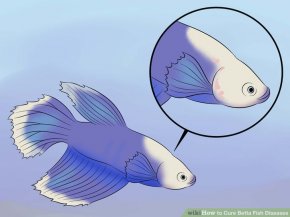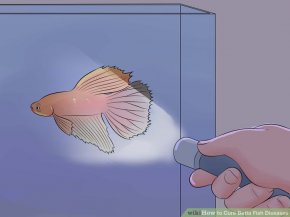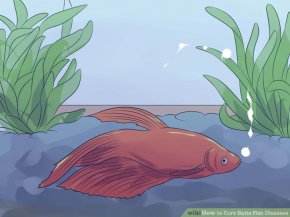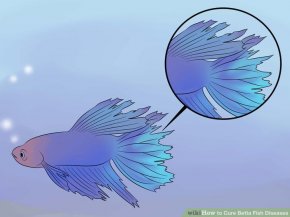
Notice if your fish’s fins look clumpy or your fish is not as active as he usually is. Your Betta may also have a paler hue than normal and white, cotton-like patches on his body. These are all signs of a fungal infection. Fungus can grow in tanks that are not treated with salt and Aquarisol once the tank water is added.
- The fungus can spread quickly from one infected fish to the other fish in the tank so it should be treated right away.
Inspect your Betta fish’s eyes to see if one eye or both eyes are protruding from his head. This is a symptom of a bacterial infection called popeye. Your fish may have developed popeye due to dirty tank water, or due to a more serious illness like tuberculosis. Sadly, tuberculosis is not curable in fish and is fatal for Betta fish. Tuberculosis can cause curved spines (not to be confused with the natural "hump" that older bettas develop). Check if your fish has any protruding scales or looks bloated. These are symptoms of dropsy, which is a bacterial infection in your fish’s kidneys. It can cause renal failure and fluid accumulation, or bloating. It often occurs in fish that are weakened due to poor water conditions or from eating contaminated food.
- Once your fish suffers from kidney failure as a result of fluid buildup, your fish will likely die. You can prevent your fish from contracting dropsy by not feeding him live worms or contaminated food. Aquarium salt baths can draw out fluid, and medicines can help.
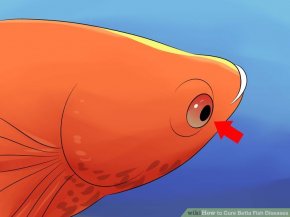 Since it's hard to know what medicines are appropriate, and usually dropsy worsens quickly, painlessly euthanizing is acceptable.
Since it's hard to know what medicines are appropriate, and usually dropsy worsens quickly, painlessly euthanizing is acceptable.
Note if your fish is covered in white specks or spots that look like salt or sand. This is a sign of fish ick or ich. The spots may be slightly raised and your fish will likely scratch against objects in the tank due to irritated and itchy skin. Your fish may also have respiratory issues and appear to gasp at the surface of the tank water. Ick attacks fish that are stressed due to irregular water temperature and pH fluctuations in the water.
Look to see if your fish’s tail or fins are fraying or appear faded. These are all signs of a bacterial infection that causes your fish’s fins, tail and mouth to rot. Rot typically occurs in fish who are bullied by other fish in the tank or who are injured by a fin-nipping tank mate. A poor tank environment can also contribute to the development of rot.
- Luckily, most Betta fish can regrow their tail and fins if rot is treated in time. However, your Betta fish’s tail and fins may not be as vibrant as they once were when they grow back.
- Some Betta fish can contract advanced body and fin rot when a case of regular fin rot goes untreated for a long period of time.
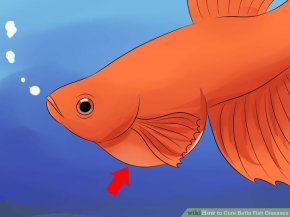 Your fish may lose his fins and body tissue as the rot progresses. Once the rot eats your fish’s body tissues, it can be difficult to cure the advanced rot and your fish will essentially be eaten alive.
Your fish may lose his fins and body tissue as the rot progresses. Once the rot eats your fish’s body tissues, it can be difficult to cure the advanced rot and your fish will essentially be eaten alive.
Shine a flashlight on your Betta to see if his body looks gold or rusty in color. This is a symptom of velvet, which is a parasite that is highly contagious. If your Betta has velvet, he may also clamp his fins close to his body, start to lose his color, have a lack of appetite, and may scratch against the sides of the tank or the gravel in the tank.
- As velvet is a highly contagious parasite, you should treat all the fish in your tank if one fish shows signs of velvet.
Check if your fish is floating on one side or is not moving at the bottom of the tank. These are signs of swim bladder disorder, a common illness among Betta fish. Swim bladder disorder is caused by overfeeding your Betta fish, leading to a swollen swim bladder that causes your fish to float on one side or the lie at the bottom of the tank because swimming becomes too difficult.
- Keep in mind swim bladder is easy to treat and does not hurt your fish, so you do not need to worry about your fish dying due to swim bladder.
Note if there are any whitish-green threads on your fish’s skin. This is a symptom of anchor worms, which are small crustaceans that burrow into your fish’s skin and enter his muscles. They then release eggs in your fish before they die, leaving behind damage in your fish that can become infected. Your Betta can contract an external parasite like anchor worms due to exposure at the pet store, from his food, or from infected fish who are introduced to his tank.
- Your fish may also scratch against objects to try to remove the anchor worms, and the points where the anchor worms are attached to your fish may be swollen.
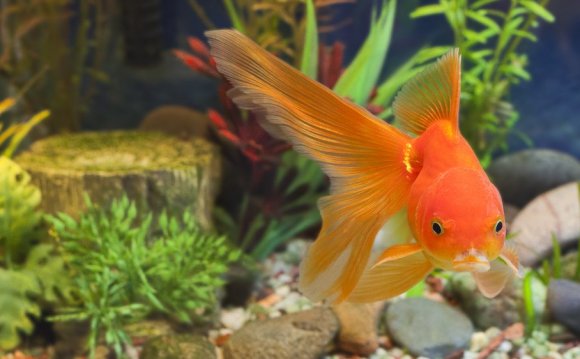
 Notice if your fish’s fins look clumpy or your fish is not as active as he usually is. Your Betta may also have a paler hue than normal and white, cotton-like patches on his body. These are all signs of a fungal infection. Fungus can grow in tanks that are not treated with salt and Aquarisol once the tank water is added.
Notice if your fish’s fins look clumpy or your fish is not as active as he usually is. Your Betta may also have a paler hue than normal and white, cotton-like patches on his body. These are all signs of a fungal infection. Fungus can grow in tanks that are not treated with salt and Aquarisol once the tank water is added.
 Since it's hard to know what medicines are appropriate, and usually dropsy worsens quickly, painlessly euthanizing is acceptable.
Since it's hard to know what medicines are appropriate, and usually dropsy worsens quickly, painlessly euthanizing is acceptable. Your fish may lose his fins and body tissue as the rot progresses. Once the rot eats your fish’s body tissues, it can be difficult to cure the advanced rot and your fish will essentially be eaten alive.
Your fish may lose his fins and body tissue as the rot progresses. Once the rot eats your fish’s body tissues, it can be difficult to cure the advanced rot and your fish will essentially be eaten alive.